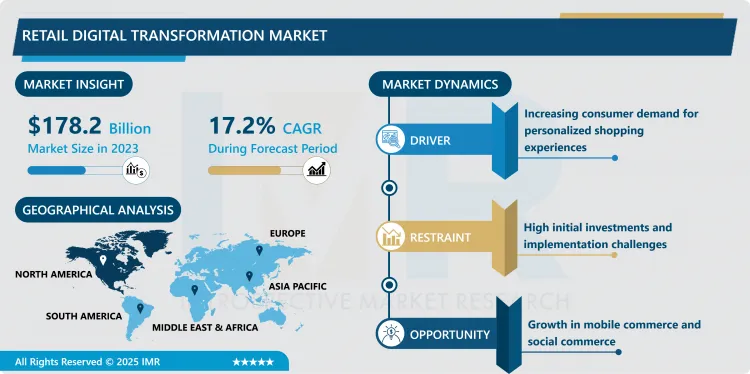Retail Digital Transformation Market Synopsis:
Retail Digital Transformation Market Size Was Valued at USD 178.2 Billion in 2023, and is Projected to Reach USD 743.4 Billion by 2032, Growing at a CAGR of 17.2% From 2024-2032.
The Retail Digital Transformation Market defines a broad spectrum of products and services including key retail technologies to transform the retail industry. From this market, the organization can pursue the adoption of sophisticated technologies like, artificial intelligence (AI), machine learning (ML), cloud computing, big data, and analytics, and the IoT for the purpose of fulfilling retail business goals, satisfying customers and improving the bottom line. Spurred by advent of new age retailing such omnichannel retailing, personal selling, the need for business intelligence that can enable right decisions at the right time and for the right reasons are some of the key factors driving digital transformation in businesses. These changes allow retailers to better integrate supply chain networks, manage strong e-business models, alter physical shopping environments through augmented reality and virtual reality, and use analysis to predict the next demands of customers.
The Retail Digital Transformation Market has seen a massive trend in the last couple of years due to the growing advancements in technologies to cater to a new generation of digital-savvy customers. Merchants remain focused on developing technologies that will provide for smooth omnichannel shopping experience. The breakout of COVID-19 early this year forced organizations to adapt new strategies to minimize disruption and changing customer behavior hence there is a surge in digital first. Retail digital transformation is not just a trend in this day and age, but a reality for coping with existing and emerging competition and market influences and growth steered by the use of artificial intelligence chatbots, advanced data analytics marketing, and real time inventory management.
Secondly, it is the growth in mobile commerce and the rise in the adoption of smart mobile devices as a vehicle for accessing the market. People expect to be treated as individuals and have called on retailers to harness big data and new generation artificial intelligent marketing platforms. Retailers are also using cloud solution to enhance their IT design, cut on expenses and enhance on flexibility. Also, the increasing use of social commerce and the implementation of blockchain solution in the retail business are opening up other vital opportunities for growth.


Retail Digital Transformation Market Trend Analysis:
Rise of AI-Powered Personalization in Retail
- The next key trend which defines the Retail Digital Transformation Market innovation is artificial intelligence-based personalization. The common practice observed nowadays is the application of artificial intelligence and machine learning to process great volumes of customer data to create unique shopping experiences. From the targeted promotion based on the previous purchases to the offers developed based on a specific consumer, personalization is opening new horizons for retailers. This is also coupled with the growth of Natural Language Processing (NLP) this gives retailers an opportunity to interact with its customers via conversational AI and voice commerce. This expanding definition of personalization plays them right into the hands of smart retailers who are willing to harness the power of artificial intelligence.
Expansion of Omnichannel Retail Strategies
- By using the concept of omnichannel retail strategies, the Retail Digital Transformation Market is a good prospect. The buyers of products and services today require, ease in purchasing of products via the internet, physical stores, and application. By adopting unified digital environments – live inventory tracking and other advanced technologies, such as CRM, in combination with one-stop digital-shopping platforms, customers will experience a seamless, integrated journey in their shopping experiences. Furthermore, refinement in the mobile wallet as well as contactless payment systems is much likely to boost the pace of transaction in a safe and efficient manner. The opportunity is to build on these technologies to respond to these requirements while also learning more about shopping behaviors to nurture loyalty and sustained revenues.
Retail Digital Transformation Market Segment Analysis:
Retail Digital Transformation Market is Segmented on the basis of Type, Delivery Mode, End user, and Region
By Type, Healthcare Payer Solutions segment is expected to dominate the market during the forecast period
- The role of driving the Healthcare Payer Solutions segment of the global Retail Digital Transformation Market will do so during the forecast timeframe owing to improving the efficiency of administrative activities such as claims. With the increased blurring of the line between retail and healthcare including self-care and pharmacy operations traditional health care payer based digital transformation projects are becoming more popular. It has been established that retailers are implementing these solutions to meet compliance, enhance perception and below-cost objectives.
- In addition, it allows an insight into the consumer’s health and encourages retailers to help consumers lead healthier lives; also providing integrated opportunities for customized loyalty schemes and health alternatives. Considering the growing role of health and wellness in today’s retailing, this segment looks set to sustain the expansion with health giants teaming up with retail powerhouses.
By Delivery Mode, Cloud Based segment expected to held the largest share
- Cloud services are expected to remain dominant in the Retail Digital Transformation Market due to the factors such as cost and flexibility of scale. Businessmen are gradually shifting their point of sales hardware environments to cloud to boost functionality and simplicity over physical hosted systems. The solutions under deployment are situated in the cloud, which means that the obtained information can be used in real time, allowing retailers to make the right decisions and then to respond to the existing shifts in the market accordingly.
- In the meantime, the usage of SaaS solutions for the retail sector is quoting; for example, they can optimize processes, enhance the management of omnichannel strategies, and address consumers. As businesses aim to increase their flexibility and creativity, products based on the cloud technology will remain leading in the market and expand the functionality of genuine values like predictive analysis, inventory management, and customer behaviour mapping.
Retail Digital Transformation Market Regional Insights:
North America is Expected to Dominate the Market Over the Forecast period
- The Retail Digital Transformation Market was led by North America. The leadership can be attributed to having adopted leading edge technologies from an early stage, a well-developed e-commerce market and large investments in e-commerce by market-leading mass merchants. The United States has become pivotal to growth in the developed markets where many leading retailers are using innovative solutions for improving customer experience and supply chain efficiency, including Walmart, Amazon and Target. However, the availability of key technology providers and supply chain’s shifting focus towards sustainability and responsible sourcing is also supporting the North American market further.
Active Key Players in the Retail Digital Transformation Market:
- Accenture (Ireland)
- Adobe Inc. (United States)
- Amazon Web Services (United States)
- Capgemini (France)
- Cognizant (United States)
- Google LLC (United States)
- IBM Corporation (United States)
- Infosys Limited (India)
- Microsoft Corporation (United States)
- Oracle Corporation (United States)
- Salesforce Inc. (United States)
- SAP SE (Germany)
- Tata Consultancy Services (India)
- Tech Mahindra (India)
- Wipro Limited (India)
- Other Active Players
|
Retail Digital Transformation Market |
|||
|
Base Year: |
2023 |
Forecast Period: |
2024-2032 |
|
Historical Data: |
2017 to 2023 |
Market Size in 2023: |
USD 178.2 Billion |
|
Forecast Period 2024-32 CAGR: |
17.2% |
Market Size in 2032: |
USD 743.4 Billion |
|
Segments Covered: |
By Type |
|
|
|
By Delivery Mode |
|
||
|
By End User |
|
||
|
By Region |
|
||
|
Key Market Drivers: |
|
||
|
Key Market Restraints: |
|
||
|
Key Opportunities: |
|
||
|
Companies Covered in the report: |
|
||
1.1 Scope and Coverage
Chapter 2:Executive Summary
Chapter 3: Market Landscape
3.1 Market Dynamics
3.1.1 Drivers
3.1.2 Restraints
3.1.3 Opportunities
3.1.4 Challenges
3.2 Market Trend Analysis
3.3 PESTLE Analysis
3.4 Porter's Five Forces Analysis
3.5 Industry Value Chain Analysis
3.6 Ecosystem
3.7 Regulatory Landscape
3.8 Price Trend Analysis
3.9 Patent Analysis
3.10 Technology Evolution
3.11 Investment Pockets
3.12 Import-Export Analysis
Chapter 4: Retail Digital Transformation Market by Type (2018-2032)
4.1 Retail Digital Transformation Market Snapshot and Growth Engine
4.2 Market Overview
4.3 Healthcare Payer Solutions
4.3.1 Introduction and Market Overview
4.3.2 Historic and Forecasted Market Size in Value USD and Volume Units
4.3.3 Key Market Trends, Growth Factors, and Opportunities
4.3.4 Geographic Segmentation Analysis
4.4 Healthcare Provider Solutions
4.5 Services
Chapter 5: Retail Digital Transformation Market by Delivery Mode (2018-2032)
5.1 Retail Digital Transformation Market Snapshot and Growth Engine
5.2 Market Overview
5.3 Cloud Based
5.3.1 Introduction and Market Overview
5.3.2 Historic and Forecasted Market Size in Value USD and Volume Units
5.3.3 Key Market Trends, Growth Factors, and Opportunities
5.3.4 Geographic Segmentation Analysis
5.4 On-premises
Chapter 6: Retail Digital Transformation Market by End User (2018-2032)
6.1 Retail Digital Transformation Market Snapshot and Growth Engine
6.2 Market Overview
6.3 Payer
6.3.1 Introduction and Market Overview
6.3.2 Historic and Forecasted Market Size in Value USD and Volume Units
6.3.3 Key Market Trends, Growth Factors, and Opportunities
6.3.4 Geographic Segmentation Analysis
6.4 Provider
Chapter 7: Company Profiles and Competitive Analysis
7.1 Competitive Landscape
7.1.1 Competitive Benchmarking
7.1.2 Retail Digital Transformation Market Share by Manufacturer (2024)
7.1.3 Industry BCG Matrix
7.1.4 Heat Map Analysis
7.1.5 Mergers and Acquisitions
7.2 ACCENTURE (IRELAND)
7.2.1 Company Overview
7.2.2 Key Executives
7.2.3 Company Snapshot
7.2.4 Role of the Company in the Market
7.2.5 Sustainability and Social Responsibility
7.2.6 Operating Business Segments
7.2.7 Product Portfolio
7.2.8 Business Performance
7.2.9 Key Strategic Moves and Recent Developments
7.2.10 SWOT Analysis
7.3 ADOBE INC. (UNITED STATES)
7.4 AMAZON WEB SERVICES (UNITED STATES)
7.5 CAPGEMINI (FRANCE)
7.6 COGNIZANT (UNITED STATES)
7.7 GOOGLE LLC (UNITED STATES)
7.8 IBM CORPORATION (UNITED STATES)
7.9 INFOSYS LIMITED (INDIA)
7.10 MICROSOFT CORPORATION (UNITED STATES)
7.11 ORACLE CORPORATION (UNITED STATES)
7.12 SALESFORCE INC. (UNITED STATES)
7.13 SAP SE (GERMANY)
7.14 TATA CONSULTANCY SERVICES (INDIA)
7.15 TECH MAHINDRA (INDIA)
7.16 WIPRO LIMITED (INDIA)
7.17 OTHER ACTIVE PLAYERS
Chapter 8: Global Retail Digital Transformation Market By Region
8.1 Overview
8.2. North America Retail Digital Transformation Market
8.2.1 Key Market Trends, Growth Factors and Opportunities
8.2.2 Top Key Companies
8.2.3 Historic and Forecasted Market Size by Segments
8.2.4 Historic and Forecasted Market Size by Type
8.2.4.1 Healthcare Payer Solutions
8.2.4.2 Healthcare Provider Solutions
8.2.4.3 Services
8.2.5 Historic and Forecasted Market Size by Delivery Mode
8.2.5.1 Cloud Based
8.2.5.2 On-premises
8.2.6 Historic and Forecasted Market Size by End User
8.2.6.1 Payer
8.2.6.2 Provider
8.2.7 Historic and Forecast Market Size by Country
8.2.7.1 US
8.2.7.2 Canada
8.2.7.3 Mexico
8.3. Eastern Europe Retail Digital Transformation Market
8.3.1 Key Market Trends, Growth Factors and Opportunities
8.3.2 Top Key Companies
8.3.3 Historic and Forecasted Market Size by Segments
8.3.4 Historic and Forecasted Market Size by Type
8.3.4.1 Healthcare Payer Solutions
8.3.4.2 Healthcare Provider Solutions
8.3.4.3 Services
8.3.5 Historic and Forecasted Market Size by Delivery Mode
8.3.5.1 Cloud Based
8.3.5.2 On-premises
8.3.6 Historic and Forecasted Market Size by End User
8.3.6.1 Payer
8.3.6.2 Provider
8.3.7 Historic and Forecast Market Size by Country
8.3.7.1 Russia
8.3.7.2 Bulgaria
8.3.7.3 The Czech Republic
8.3.7.4 Hungary
8.3.7.5 Poland
8.3.7.6 Romania
8.3.7.7 Rest of Eastern Europe
8.4. Western Europe Retail Digital Transformation Market
8.4.1 Key Market Trends, Growth Factors and Opportunities
8.4.2 Top Key Companies
8.4.3 Historic and Forecasted Market Size by Segments
8.4.4 Historic and Forecasted Market Size by Type
8.4.4.1 Healthcare Payer Solutions
8.4.4.2 Healthcare Provider Solutions
8.4.4.3 Services
8.4.5 Historic and Forecasted Market Size by Delivery Mode
8.4.5.1 Cloud Based
8.4.5.2 On-premises
8.4.6 Historic and Forecasted Market Size by End User
8.4.6.1 Payer
8.4.6.2 Provider
8.4.7 Historic and Forecast Market Size by Country
8.4.7.1 Germany
8.4.7.2 UK
8.4.7.3 France
8.4.7.4 The Netherlands
8.4.7.5 Italy
8.4.7.6 Spain
8.4.7.7 Rest of Western Europe
8.5. Asia Pacific Retail Digital Transformation Market
8.5.1 Key Market Trends, Growth Factors and Opportunities
8.5.2 Top Key Companies
8.5.3 Historic and Forecasted Market Size by Segments
8.5.4 Historic and Forecasted Market Size by Type
8.5.4.1 Healthcare Payer Solutions
8.5.4.2 Healthcare Provider Solutions
8.5.4.3 Services
8.5.5 Historic and Forecasted Market Size by Delivery Mode
8.5.5.1 Cloud Based
8.5.5.2 On-premises
8.5.6 Historic and Forecasted Market Size by End User
8.5.6.1 Payer
8.5.6.2 Provider
8.5.7 Historic and Forecast Market Size by Country
8.5.7.1 China
8.5.7.2 India
8.5.7.3 Japan
8.5.7.4 South Korea
8.5.7.5 Malaysia
8.5.7.6 Thailand
8.5.7.7 Vietnam
8.5.7.8 The Philippines
8.5.7.9 Australia
8.5.7.10 New Zealand
8.5.7.11 Rest of APAC
8.6. Middle East & Africa Retail Digital Transformation Market
8.6.1 Key Market Trends, Growth Factors and Opportunities
8.6.2 Top Key Companies
8.6.3 Historic and Forecasted Market Size by Segments
8.6.4 Historic and Forecasted Market Size by Type
8.6.4.1 Healthcare Payer Solutions
8.6.4.2 Healthcare Provider Solutions
8.6.4.3 Services
8.6.5 Historic and Forecasted Market Size by Delivery Mode
8.6.5.1 Cloud Based
8.6.5.2 On-premises
8.6.6 Historic and Forecasted Market Size by End User
8.6.6.1 Payer
8.6.6.2 Provider
8.6.7 Historic and Forecast Market Size by Country
8.6.7.1 Turkiye
8.6.7.2 Bahrain
8.6.7.3 Kuwait
8.6.7.4 Saudi Arabia
8.6.7.5 Qatar
8.6.7.6 UAE
8.6.7.7 Israel
8.6.7.8 South Africa
8.7. South America Retail Digital Transformation Market
8.7.1 Key Market Trends, Growth Factors and Opportunities
8.7.2 Top Key Companies
8.7.3 Historic and Forecasted Market Size by Segments
8.7.4 Historic and Forecasted Market Size by Type
8.7.4.1 Healthcare Payer Solutions
8.7.4.2 Healthcare Provider Solutions
8.7.4.3 Services
8.7.5 Historic and Forecasted Market Size by Delivery Mode
8.7.5.1 Cloud Based
8.7.5.2 On-premises
8.7.6 Historic and Forecasted Market Size by End User
8.7.6.1 Payer
8.7.6.2 Provider
8.7.7 Historic and Forecast Market Size by Country
8.7.7.1 Brazil
8.7.7.2 Argentina
8.7.7.3 Rest of SA
Chapter 9 Analyst Viewpoint and Conclusion
9.1 Recommendations and Concluding Analysis
9.2 Potential Market Strategies
Chapter 10 Research Methodology
10.1 Research Process
10.2 Primary Research
10.3 Secondary Research
|
Retail Digital Transformation Market |
|||
|
Base Year: |
2023 |
Forecast Period: |
2024-2032 |
|
Historical Data: |
2017 to 2023 |
Market Size in 2023: |
USD 178.2 Billion |
|
Forecast Period 2024-32 CAGR: |
17.2% |
Market Size in 2032: |
USD 743.4 Billion |
|
Segments Covered: |
By Type |
|
|
|
By Delivery Mode |
|
||
|
By End User |
|
||
|
By Region |
|
||
|
Key Market Drivers: |
|
||
|
Key Market Restraints: |
|
||
|
Key Opportunities: |
|
||
|
Companies Covered in the report: |
|
||
Frequently Asked Questions :
The forecast period in the Retail Digital Transformation Market research report is 2024-2032.
Accenture (Ireland), Adobe Inc. (United States), Amazon Web Services (United States), Capgemini (France), Cognizant (United States), Google LLC (United States), IBM Corporation (United States), Infosys Limited (India), Microsoft Corporation (United States), Oracle Corporation (United States), Salesforce Inc. (United States), SAP SE (Germany), Tata Consultancy Services (India), Tech Mahindra (India), Wipro Limited (India), and Other Active Players.
The Retail Digital Transformation Market is segmented into Type, Delivery Mode, End User and region. By Type, the market is categorized into Healthcare Payer Solutions, Healthcare Provider Solutions, Services. By Delivery Mode, the market is categorized into Cloud Based, On-premises. By End User, the market is categorized into Payer, Provider. By region, it is analyzed across North America (U.S.; Canada; Mexico), Eastern Europe (Bulgaria; The Czech Republic; Hungary; Poland; Romania; Rest of Eastern Europe), Western Europe (Germany; UK; France; Netherlands; Italy; Russia; Spain; Rest of Western Europe), Asia-Pacific (China; India; Japan; Southeast Asia, etc.), South America (Brazil; Argentina, etc.), Middle East & Africa (Saudi Arabia; South Africa, etc.).
The Retail Digital Transformation Market defines a broad spectrum of products and services including key retail technologies to transform the retail industry. From this market, the organization can pursue the adoption of sophisticated technologies like, artificial intelligence (AI), machine learning (ML), cloud computing, big data, and analytics, and the IoT for the purpose of fulfilling retail business goals, satisfying customers and improving the bottom line. Spurred by advent of new age retailing such omnichannel retailing, personal selling, the need for business intelligence that can enable right decisions at the right time and for the right reasons are some of the key factors driving digital transformation in businesses. These changes allow retailers to better integrate supply chain networks, manage strong e-business models, alter physical shopping environments through augmented reality and virtual reality, and use analysis to predict the next demands of customers.
Retail Digital Transformation Market Size Was Valued at USD 178.2 Billion in 2023, and is Projected to Reach USD 743.4 Billion by 2032, Growing at a CAGR of 17.2% From 2024-2032.













